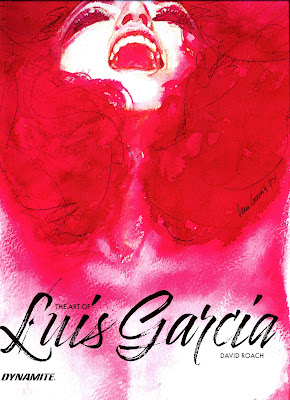Thursday, September 22, 2022
Book Review: 'Alfred Hitchcock: A Hearse of a Different Color'
Sunday, September 18, 2022
The Art of Luis Garcia
by David Roach
Dynamite, 2021
In the early 70s Garcia, growing tired of illustrating romance comics, began supplying work for the French comic magazine Pilote. Some of those pieces later were reprinted in English in the Warren magazines in the U.S.
Along with recounting Garcia's adventures in comics, author Roach provides some interesting anecdotes and insights, from Garcia himself, about the artistic milieu in Spain and Europe in the era of the 1960s and 1970s. Fort example, it was Garcia's girlfriend, Carol (Juana) De Haro, who served as the model for Vampirella:
In 1982 Garcia's comic series 'Nova 2' was printed in Heavy Metal magazine, and became another standout in his comics career. Unlike his previous works for the UK comics, Pilote, and Warren, 'Nova 2 reflected Garcia's increasing interest in exploring 'deep' themes of existential and psychological crises.
Thursday, September 15, 2022
Two articles on Baby Boomer Favorites
Wednesday, September 14, 2022
Book Review: Solomon Kane novelization
Sunday, September 11, 2022
The Time Machinate
by Nicola Cuti
from the December, 1982 issue of Heavy Metal magazine
Thursday, September 8, 2022
Book Review: Forsake the Sky
'Forsake the Sky' is a traditional sci-fi adventure, with a Ruritanian flavoring derived from affectionate portrayals of swordfights, the enjoyment of fine liqueurs, pipe-smoking, gourmet meals, and conversations held in well-appointed drawing-rooms. One can see themes in this novel that author Powers later was to incorporate into such works as 'The Drawing of the Dark'.
Tuesday, September 6, 2022
Out of Work
by Gary U.S. Bonds
It's the week of September 11, 1982, and after peaking at number 21 on the Billboard Hot 100 chart in August, 'Out of Work', the single from Gary 'U.S.' Bonds, is at number 61 and on its way down the charts.
The song, which was a track on Bonds's 1982 album On the Line, was written by Bruce Springsteen.
For me, living in upstate New York at that time and in my final year of college, the song had a real resonance (the Comments at the YouTube page for 'Out of Work' are illuminating).
The great Recession of 1981 - 1982 was going on, and the national unemployment rate stood at nearly 11 %. While some areas of the country were prospering from 'Reaganomics', upstate New York and the wider Rust Belt were in pretty bad shape. Factories were closing and the blue collar jobs, that had allowed anyone with a high school diploma and a decent work ethic to earn a good living, fast were evaporating.
It was plain that finding a good job in my hometown was increasingly difficult. Many of the people in my age cohort were leaving New York state for the Sun Belt and better prospects. And indeed, I was to do just that in 1984.............and I haven't lived north of the Mason Dixon line since..........
Feet beatin' on the sidewalk
Down at the unemployment agency
All I get's talk
I check the want ads but there
Just ain't nobody hiring
What's a man supposed to do
When he's down and
I need a job, I'm out of work
I'm unemployed, I'm out of work
I need a job, I'm out of work
Her name is Linda Brown
Her dad invites me in
He tells me to sit down
The small talk that we're making
Is going pretty smooth
But then he drops a bomb
"Son, what d'ya do?"
I need a job, I'm out of work
I'm unemployed, I'm out of work
I need a job, I'm out of work
Yeah, yeah, yeah
I know you got your plans
You're doing all you can now
To aid the little man
We got to do our best to
Whip that inflation down
Maybe you got a job for me
Just driving you around
To make a man lose his mind
(I'm out of work)
Up there you got a job but down here below
I need a job, I'm out of work
I'm unemployed, I'm out of work
I need a job, I'm out of work
I'm out of work
I'm out of work
I'm out of work
I'm out of work
I'm out of work
I'm out of work
Sunday, September 4, 2022
Paydirt from Creepy issue 124
by Roger McKenzie (story) and Carmine Infantino and Alfredo Alcala (art)
from Creepy issue 124, January 1981































































